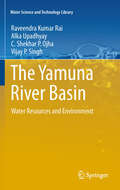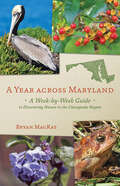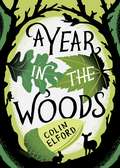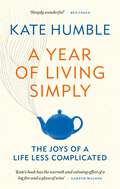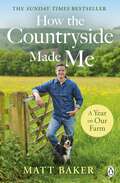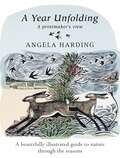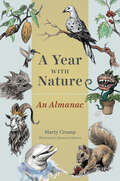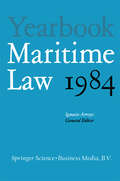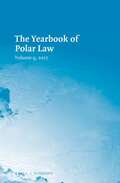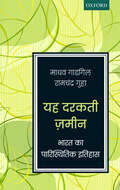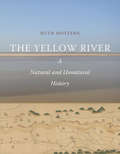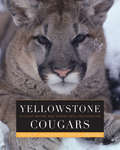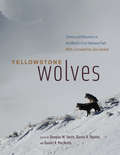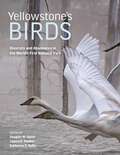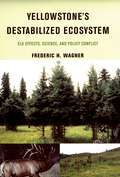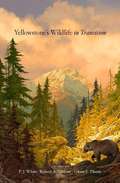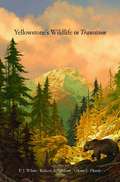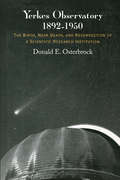- Table View
- List View
The Yamuna River Basin: Water Resources and Environment (Water Science and Technology Library #66)
by Raveendra Kumar Rai Alka Upadhyay C. Shekhar Ojha Vijay P. SinghThis book is designed to provide concepts, methodologies, and approaches for river basin studies with respect to water resources and environment. The book is not limited to the Yamuna River basin, but will help in the study of various other river basins for integrated water resources management. The book covers the essential components of integrated water resources management, including analysis of climatic variables, climate change detection, analysis of natural resources, geology, geomorphology, socio-economics, water budgeting, flood estimation, river pollution, etc. Furthermore, the book addresses recent issues pertaining to water quality, water quality indices, environmental flows, water resources management through cropping pattern change, etc. along with methodologies and application to the Yamuna River system. However, the main objective of this book is to address important issues of water resources management of river basins. Audience: The manuscript has been designed so that it can be used as a reference for river basin studies. The book will be useful to engineers, agricultural scientists, environmentalists, planners, managers, and administrators who are concerned with water resources.
Yankee Mission: Thomas Kydd 25 (Thomas Kydd #36)
by Julian Stockwin1812. Off the coast of Brazil, HMS Java, a proud British 38-gun frigate, is captured in battle by the American USS Constitution - signaling across the world's oceans a challenge to Britain's naval premiership that cannot be ignored.Back in EnglandCaptainSir Thomas Kydd is enjoying a moment of normal life with his wife and his newborn son. With his Thunderer in dock receiving some well-earned repairs he is, momentarily, without a command. It's a position the Admiralty does not leave him in for long, and he is soon given a mission: engage the young republic in a fair fight, frigate against frigate, and restore the Navy's reputation. And they have just the ship and crew for him . . . Tyger. But on reaching the US east coast, Kydd and his trusted Tygers realise that the hardest part of their mission will be drawing out one of the Yankee men-o'-war to engage in battle - especially once the Americans get wind of his purpose. It's a tall order, requiring every ounce of the crew's guile and persistence - and when fortune turns against them, Kydd finds not only his career, but his life, hanging in the balance.Praise for Julian Stockwin's Kydd series:'A very readable and enjoyable story . . . I can only recommend that you go out, beg, borrow or buy, and enjoy' - Bernard Cornwell 'In Stockwin's hands the sea story will continue to entrance readers across the world' - Guardian'The characterization is first-class, and the reader quickly becomes involved with all that happens' - Historical Novels Review
A Year across Maryland: A Week-by-Week Guide to Discovering Nature in the Chesapeake Region
by Bryan MacKayWhen can you find ripe blueberries along the Appalachian Trail in Maryland? Where can you see the air filled with monarch butterflies as they migrate south each autumn? If you want to enjoy nature this weekend, where is the best place to visit? Bryan MacKay can tell you.Written as an almanac, A Year across Maryland invites you to explore the natural world throughout the year, from watching bald eagles nesting in January to harvesting mistletoe in December. Entries identify the best time and place to experience such wonders as wildflowers blooming, birds in migration, amphibians singing, and morel mushrooms ready to be picked, sliced, sautéed, and devoured. Color photographs of more than seventy species enrich and illustrate the text. Every week of the year has a recommended "Trip of the Week." Personal essays that draw from MacKay's field notes provide an intimate glimpse into a biologist encounters with plants and animals over the years.Whether you want to see snow geese and trumpeter swans pausing in their northward migration each March, or the mating "jubilee" of polychaete worms during the new moon in May, A Year across Maryland offers valuable advice for the spontaneous adventurer and the serious planner alike.
A Year in the Woods: The Diary of a Forest Ranger
by Craig Taylor Colin ElfordColin Elford's A Year in the Woods is an enthralling journey into the heart of the English countryside - with a preamble by Craig Taylor.Colin Elford spends his days alone - alone but for the deer, the squirrels, the rabbits, the birds, and the many other creatures inhabiting the woods.From the crisp cold of January, through the promise of spring and the heat of summer, and then into damp autumn and the chill winds of winter, we accompany the forest-ranger as he goes about his work - stalking in the early morning darkness, putting an injured fallow buck out of its misery, watching stoats kill a hare, observing owls, and simply being a part of the outdoors.Colin Elford immerses himself in the richly diverse and unique landscapes of Britain, existing in rhythm with natural environments. For fans of Robert Macfarlane's Landmarks, Helen Macdonald's H is for Hawk orJames Rebanks' A Shepherd's Life, Colin's rare and uplifiting journey will unveil the true nature and beauty of Britain's countryside.'This is nature for real . . . Elford describes woodland wonders in short paragraphs of luminous intensity' Daily Mail'A poetic insight in the world of hidden Nature' Countryman'Stalking sharpens the senses and there is an almost hallucinatory clarity to Elford's writing' Observer'Refreshingly unsentimental. Contains some wonderful descriptions and sentences which are so profound they demand a second reading' Sunday ExpressColin Elford is a forest ranger on the Dorset/Wiltshire border. Craig Taylor is the author of Return to Akenfield and One Million Tiny Plays About Britain and the editor of the magazine Five Dials.
A Year of Living Simply: The joys of a life less complicated (Kate Humble)
by Kate Humble'Simply wonderful.' - BEN FOGLE'Kate's book has the warmth and calming effect of a log fire and a glass of wine. Unknit your brow and let go. It's a treat.' - GARETH MALONE'Kate Humble pours her enviable knowledge into attainable goals. It's a winning combination and the prize - a life in balance with nature - is definitely worth claiming.' - LUCY SIEGLE'As ever, where Kate leads, I follow. She has made me reassess and reset.' - DAN SNOW'Kate Humble's new book is a lesson in moving on from a tragedy and finding our place in the world' - WOMAN & HOME'A Year of Living Simply is timely, given that the pandemic has forced most of us, in some way to simplify our lives, whether we planned to or not. Kate wrote it before any of us were aware of the upcoming crisis, but it captures the current moment perfectly... It's not necessarily a "how to" book, more of a "why not try?" approach.' - FRANCESCA BABB, MAIL ON SUNDAY YOU'What I particularly love is her philosophy for happiness, which is the subject of her new book, A Year of Living Simply. The clue is in the title. Remember the basics. Instead of barging through the day on autopilot, really stop to think about the tiniest little things that added a moment of joy. No, of course stopping and smelling the flowers won't cure all our ills and woes. But taking the time to savour the things that bring pleasure, really being in that moment and appreciating it, can remind you that most days have moments that buoy your mood.' - JO ELVIN, MAIL ON SUNDAY YOUIf there is one thing that most of us aspire to, it is, simply, to be happy. And yet attaining happiness has become, it appears, anything but simple. Having stuff - The Latest, The Newest, The Best Yet - is all too often peddled as the sure fire route to happiness. So why then, in our consumer-driven society, is depression, stress and anxiety ever more common, affecting every strata of society and every age, even, worryingly, the very young? Why is it, when we have so much, that many of us still feel we are missing something and the rush of pleasure when we buy something new turns so quickly into a feeling of emptiness, or purposelessness, or guilt?So what is the route to real, deep, long lasting happiness? Could it be that our lives have just become overly crowded, that we've lost sight of the things - the simple things - that give a sense of achievement, a feeling of joy or excitement? That make us happy. Do we need to take a step back, reprioritise? Do we need to make our lives more simple? Kate Humble's fresh and frank exploration of a stripped-back approach to life is uplifting, engaging and inspiring - and will help us all find balance and happiness every day.
A Year on Our Farm: How the Countryside Made Me
by Matt BakerEscape into nature with Matt Baker in his first ever book - a diary of the natural year and a glimpse into family life on the farmPeppered with his hand drawn sketches and moments from his TV career throughout, this is a heartfelt and fascinating insight into Matt's life outside of our TV screens_______Matt Baker is at his happiest on the farm.Away from the bright lights of hosting our favourite television programmes, Countryfile, The One Show, Blue Peter and many more, he is often in the company of his family, dogs, array of sheep, Mediterranean miniature donkeys and a whole host of wildlife in the farm's ancient woodland.Now, following the ever-changing seasons, Matt takes us on a journey with his family on the farm.We see woodland animals emerge after a long winter of hibernation, hear the dawn chorus in the height of summer and see the preparations unfold for the harsh and wild winter months.Peppered with hand drawn sketches, unforgettable moments from his TV career and stories of a landscape you'll fall in love with, Matt offers readers a touching insight into life on the farm, and how the power and beauty of the countryside can be an inspiration and source of joy for all of us.A celebration of the natural year, Matt Baker takes us on a journey through the seasons, his life on the farm and how the power and beauty of the countryside has made him who he is.
A Year Unfolding: A Printmaker's View
by Angela HardingA beautifully illustrated guide to nature through the seasons by much-loved printmaker Angela Harding.The cover of this stunning book has an exclusive triptych printed on the reverse - a perfect collector's itemThis stunning work, the first book that is solely dedicated to Angela's art, is a celebration of her beautiful prints, and a glimpse into her detailed and meticulous process.A Year Unfolding is a journey through Angela's year in nature watching the seasons unfold in front of her from her studio in Rutland, and giving the reader detail into how nature transforms and evolves over the course of the year.A Year Unfolding also tells the stories behind some of Angela's most popular images, giving context to Angela's celebrated work, as well as new art created specifically for the book.The beautiful illustrations and evocative imagery of the prose make this the perfect book for Angela's fans and readers and art lovers everywhere.Angela has created the covers for many bestselling books, including The Salt Path and The Wild Silence by Raynor Winn, October, October by Katya Balen, English Pastoral by James Rebanks, Christmas is Murder by Val McDermid and RSPB Birds among many others.
A Year with Nature: An Almanac
by Marty CrumpA Year with Nature is an almanac like none you’ve ever seen: combining science and aesthetics, it is a daily affirmation of the extraordinary richness of biodiversity and our enduring beguilement by its beauty. With a text by herpetologist and natural history writer Marty Crump and a cornucopia of original illustrations by Bronwyn McIvor, this quirky quotidian reverie gazes across the globe, media, and time as it celebrates date-appropriate natural topics ranging from the founding of the National Park Service to annual strawberry, garlic, shrimp, hummingbird, and black bear festivals. With Crump, we mark the publication of classics like Carson’s Silent Spring and White’s Charlotte’s Web, and even the musical premiere of Tchaikovsky’s Swan Lake. We note the discovery of the structure of DNA and the mountain gorilla, the rise of citizen science projects, and the work of people who’ve shaped how we view and protect nature—from Aristotle to E. O. Wilson. Some days feature US celebrations, like National Poinsettia Day and National Cat Day; others highlight country-specific celebrations, like Australia’s Wombat Day and Thailand’s Monkey Buffet Festival, during which thousands of macaques feast on an ornately arranged spread of fruits and vegetables. Crump also highlights celebrations that span borders, from World Wildlife Conservation Day to International Mountain Day and global festivities for snakes, sea turtles, and chocolate. Interweaving fascinating facts on everything from jellyfish bodies to monthly birth flowers with folkloric entries featuring the Loch Ness Monster, unicorns, and ancient Greek, Roman, and Egyptian mythology, the almanac is as exhaustive as it is enchanting. A Year with Nature celebrates the wonder and beauty of our natural world as we have expressed it in visual arts, music, literature, science, natural history, and everyday experience. But more than this, the almanac’s vignettes encourage us to contemplate how we can help ensure that future generations will be able to enjoy the landscapes and rich biodiversity we so deeply cherish.
A Year with Nature: An Almanac
by Marty CrumpA Year with Nature is an almanac like none you’ve ever seen: combining science and aesthetics, it is a daily affirmation of the extraordinary richness of biodiversity and our enduring beguilement by its beauty. With a text by herpetologist and natural history writer Marty Crump and a cornucopia of original illustrations by Bronwyn McIvor, this quirky quotidian reverie gazes across the globe, media, and time as it celebrates date-appropriate natural topics ranging from the founding of the National Park Service to annual strawberry, garlic, shrimp, hummingbird, and black bear festivals. With Crump, we mark the publication of classics like Carson’s Silent Spring and White’s Charlotte’s Web, and even the musical premiere of Tchaikovsky’s Swan Lake. We note the discovery of the structure of DNA and the mountain gorilla, the rise of citizen science projects, and the work of people who’ve shaped how we view and protect nature—from Aristotle to E. O. Wilson. Some days feature US celebrations, like National Poinsettia Day and National Cat Day; others highlight country-specific celebrations, like Australia’s Wombat Day and Thailand’s Monkey Buffet Festival, during which thousands of macaques feast on an ornately arranged spread of fruits and vegetables. Crump also highlights celebrations that span borders, from World Wildlife Conservation Day to International Mountain Day and global festivities for snakes, sea turtles, and chocolate. Interweaving fascinating facts on everything from jellyfish bodies to monthly birth flowers with folkloric entries featuring the Loch Ness Monster, unicorns, and ancient Greek, Roman, and Egyptian mythology, the almanac is as exhaustive as it is enchanting. A Year with Nature celebrates the wonder and beauty of our natural world as we have expressed it in visual arts, music, literature, science, natural history, and everyday experience. But more than this, the almanac’s vignettes encourage us to contemplate how we can help ensure that future generations will be able to enjoy the landscapes and rich biodiversity we so deeply cherish.
A Year with Nature: An Almanac
by Marty CrumpA Year with Nature is an almanac like none you’ve ever seen: combining science and aesthetics, it is a daily affirmation of the extraordinary richness of biodiversity and our enduring beguilement by its beauty. With a text by herpetologist and natural history writer Marty Crump and a cornucopia of original illustrations by Bronwyn McIvor, this quirky quotidian reverie gazes across the globe, media, and time as it celebrates date-appropriate natural topics ranging from the founding of the National Park Service to annual strawberry, garlic, shrimp, hummingbird, and black bear festivals. With Crump, we mark the publication of classics like Carson’s Silent Spring and White’s Charlotte’s Web, and even the musical premiere of Tchaikovsky’s Swan Lake. We note the discovery of the structure of DNA and the mountain gorilla, the rise of citizen science projects, and the work of people who’ve shaped how we view and protect nature—from Aristotle to E. O. Wilson. Some days feature US celebrations, like National Poinsettia Day and National Cat Day; others highlight country-specific celebrations, like Australia’s Wombat Day and Thailand’s Monkey Buffet Festival, during which thousands of macaques feast on an ornately arranged spread of fruits and vegetables. Crump also highlights celebrations that span borders, from World Wildlife Conservation Day to International Mountain Day and global festivities for snakes, sea turtles, and chocolate. Interweaving fascinating facts on everything from jellyfish bodies to monthly birth flowers with folkloric entries featuring the Loch Ness Monster, unicorns, and ancient Greek, Roman, and Egyptian mythology, the almanac is as exhaustive as it is enchanting. A Year with Nature celebrates the wonder and beauty of our natural world as we have expressed it in visual arts, music, literature, science, natural history, and everyday experience. But more than this, the almanac’s vignettes encourage us to contemplate how we can help ensure that future generations will be able to enjoy the landscapes and rich biodiversity we so deeply cherish.
A Year with Nature: An Almanac
by Marty CrumpA Year with Nature is an almanac like none you’ve ever seen: combining science and aesthetics, it is a daily affirmation of the extraordinary richness of biodiversity and our enduring beguilement by its beauty. With a text by herpetologist and natural history writer Marty Crump and a cornucopia of original illustrations by Bronwyn McIvor, this quirky quotidian reverie gazes across the globe, media, and time as it celebrates date-appropriate natural topics ranging from the founding of the National Park Service to annual strawberry, garlic, shrimp, hummingbird, and black bear festivals. With Crump, we mark the publication of classics like Carson’s Silent Spring and White’s Charlotte’s Web, and even the musical premiere of Tchaikovsky’s Swan Lake. We note the discovery of the structure of DNA and the mountain gorilla, the rise of citizen science projects, and the work of people who’ve shaped how we view and protect nature—from Aristotle to E. O. Wilson. Some days feature US celebrations, like National Poinsettia Day and National Cat Day; others highlight country-specific celebrations, like Australia’s Wombat Day and Thailand’s Monkey Buffet Festival, during which thousands of macaques feast on an ornately arranged spread of fruits and vegetables. Crump also highlights celebrations that span borders, from World Wildlife Conservation Day to International Mountain Day and global festivities for snakes, sea turtles, and chocolate. Interweaving fascinating facts on everything from jellyfish bodies to monthly birth flowers with folkloric entries featuring the Loch Ness Monster, unicorns, and ancient Greek, Roman, and Egyptian mythology, the almanac is as exhaustive as it is enchanting. A Year with Nature celebrates the wonder and beauty of our natural world as we have expressed it in visual arts, music, literature, science, natural history, and everyday experience. But more than this, the almanac’s vignettes encourage us to contemplate how we can help ensure that future generations will be able to enjoy the landscapes and rich biodiversity we so deeply cherish.
Yearbook Maritime Law: Volume I
by IgnacioArroyoI. The importance of legal questions related to the sea is obvious to everyone. It is hardly surprising that the subjects that make up international current events illustrate the leading role played by maritime affairs. Indeed, it is no coincidence that three quarters of the earth's surface is covered by oceans. Territorial seas, exclusive economic zones, exploitation of the seabed, fishing, transport, insurance, collision, and pollution raise many unresolved questions. On the other hand, the contrast of this importance with the modest attention that existing periodical publications merit must be underscored. Without undervaluing these publications, there has been a need for some time to create a vehicle of common expression, based on three central tenets: interdisciplinary framework, tendency towards uniform law, and both a theoretical and practical approach. a. A framework of interdisciplinary nature seems to be relevant as it is desirable to overcome the artificial separation between public and private law.
The Yearbook of Polar Law: Volume 9, 2017 (The Yearbook Of Polar Law Ser. #9)
by Gudmundur Alfredsson Timo KoivurovaThe papers in this volume are based on presentations at ninth symposium in Akureyri in October 2016.
Yeh Darakti Zameen: Bharat ka Paristhitik Itihas
by Madhav GadgilThis Fissured Land, first published in 1992, presents an interpretative history ecological history of the Indian subcontinent. It offers a theory of ecological prudence and profligacy, testing this theory across the wide sweep of South Asian history. The book especially focuses on the use and abuse of forest resources. In Part One, the authors present a general theory of ecological history. Part Two provides a fresh interpretative history of pre-modern India along with an ecological interpretation of the caste system. In Part Three, the authors draw upon a huge wealth of source material in their socio-ecological analysis of the modes of resource use introduced in India by the British. This book is the Hindi edition translated from English.
The Yellow River: A Natural and Unnatural History (Yale Agrarian Studies Series)
by Ruth MosternA three-thousand-year history of the Yellow River and the legacy of interactions between humans and the natural landscape From Neolithic times to the present day, the Yellow River and its watershed have both shaped and been shaped by human society. Using the Yellow River to illustrate the long-term effects of environmentally significant human activity, Ruth Mostern unravels the long history of the human relationship with water and soil and the consequences, at times disastrous, of ecological transformations that resulted from human decisions. As Mostern follows the Yellow River through three millennia of history, she underlines how governments consistently ignored the dynamic interrelationships of the river’s varied ecosystems—grasslands, riparian forests, wetlands, and deserts—and the ecological and cultural impacts of their policies. With an interdisciplinary approach informed by archival research and GIS (geographical information system) records, this groundbreaking volume provides unique insight into patterns, transformations, and devastating ruptures throughout ecological history and offers profound conclusions about the way we continue to affect the natural systems upon which we depend.
Yellowstone Cougars: Ecology before and during Wolf Restoration
by Toni K. Ruth Polly C. Buotte Maurice G. HornockerYellowstone Cougars examines the effect of wolf restoration on the cougar population in Yellowstone National Park—one of the largest national parks in the American West. No other study has ever specifically addressed the theoretical and practical aspects of competition between large carnivores in North America. The authors provide a thorough analysis of cougar ecology, how they interact with and are influenced by wolves—their main competitor—and how this knowledge informs management and conservation of both species across the West. Of practical importance, Yellowstone Cougars addresses the management and conservation of multiple carnivores in increasingly human-dominated landscapes. The authors move beyond a single-species approach to cougar management and conservation to one that considers multiple species, which was impossible to untangle before wolf reestablishment in the Yellowstone area provided biologists with this research opportunity. Yellowstone Cougars provides objective scientific data at the forefront of understanding cougars and large carnivore community structure and management issues in the Greater Yellowstone Ecosystem, as well as in other areas where wolves and cougars are reestablishing. Intended for an audience of scientists, wildlife managers, conservationists, and academics, the book also sets a theoretical precedent for writing about competition between carnivorous mammals.
Yellowstone Wildlife: Ecology and Natural History of the Greater Yellowstone Ecosystem
by Paul A. JohnsgardYellowstone Wildlife is a natural history of the wildlife species that call Yellowstone National Park and the Greater Yellowstone Ecosystem their home. Illustrated with stunning images by renowned wildlife photographer Thomas Mangelsen, Yellowstone Wildlife describes the lives of species in the park, exploring their habitats from the Grand Tetons to Jackson Hole. From charismatic megafauna like elk, bison, wolves, bighorn sheep, and grizzly bears, to smaller mammals like bats, pikas, beavers, and otters, to some of the 279 species of birds, Johnsgard describes the behavior of animals throughout the seasons, with sections on what summer and autumn mean to the wildlife of the park, especially with the intrusion of millions of tourists each year. Enhanced by Mangelsen’s wildlife photography, Yellowstone Wildlife reveals the beauty and complexity of these species’ intertwined lives and that of Yellowstone’s greater ecosystem.
Yellowstone Wolves: Science and Discovery in the World's First National Park (America's Animal Comebacks Ser.)
by Douglas W. Smith Daniel R. Stahler Daniel R. MacNultyIn 2020, it will have been twenty-five years since one of the greatest wildlife conservation and restoration achievements of the twentieth century took place: the reintroduction of wolves to the world’s first national park, Yellowstone. Eradicated after the park was established, then absent for seventy years, these iconic carnivores returned to Yellowstone in 1995 when the US government reversed its century-old policy of extermination and—despite some political and cultural opposition—began the reintroduction of forty-one wild wolves from Canada and northwest Montana. In the intervening decades, scientists have studied their myriad behaviors, from predation to mating to wolf pup play, building a one-of-a-kind field study that has both allowed us to witness how the arrival of top predators can change an entire ecosystem and provided a critical window into impacts on prey, pack composition, and much else. Here, for the first time in a single book, is the incredible story of the wolves’ return to Yellowstone National Park as told by the very people responsible for their reintroduction, study, and management. Anchored in what we have learned from Yellowstone, highlighting the unique blend of research techniques that have given us this knowledge, and addressing the major issues that wolves still face today, this book is as wide-ranging and awe-inspiring as the Yellowstone restoration effort itself. We learn about individual wolves, population dynamics, wolf-prey relationships, genetics, disease, management and policy, newly studied behaviors and interactions with other species, and the rippling ecosystem effects wolves have had on Yellowstone’s wild and rare landscape. Perhaps most importantly of all, the book also offers solutions to ongoing controversies and debates. Featuring a foreword by Jane Goodall, beautiful images, a companion online documentary by celebrated filmmaker Bob Landis, and contributions from more than seventy wolf and wildlife conservation luminaries from Yellowstone and around the world, Yellowstone Wolves is a gripping, accessible celebration of the extraordinary Yellowstone Wolf Project—and of the park through which these majestic and important creatures once again roam.
Yellowstone Wolves: Science and Discovery in the World's First National Park
In 2020, it will have been twenty-five years since one of the greatest wildlife conservation and restoration achievements of the twentieth century took place: the reintroduction of wolves to the world’s first national park, Yellowstone. Eradicated after the park was established, then absent for seventy years, these iconic carnivores returned to Yellowstone in 1995 when the US government reversed its century-old policy of extermination and—despite some political and cultural opposition—began the reintroduction of forty-one wild wolves from Canada and northwest Montana. In the intervening decades, scientists have studied their myriad behaviors, from predation to mating to wolf pup play, building a one-of-a-kind field study that has both allowed us to witness how the arrival of top predators can change an entire ecosystem and provided a critical window into impacts on prey, pack composition, and much else. Here, for the first time in a single book, is the incredible story of the wolves’ return to Yellowstone National Park as told by the very people responsible for their reintroduction, study, and management. Anchored in what we have learned from Yellowstone, highlighting the unique blend of research techniques that have given us this knowledge, and addressing the major issues that wolves still face today, this book is as wide-ranging and awe-inspiring as the Yellowstone restoration effort itself. We learn about individual wolves, population dynamics, wolf-prey relationships, genetics, disease, management and policy, newly studied behaviors and interactions with other species, and the rippling ecosystem effects wolves have had on Yellowstone’s wild and rare landscape. Perhaps most importantly of all, the book also offers solutions to ongoing controversies and debates. Featuring a foreword by Jane Goodall, beautiful images, a companion online documentary by celebrated filmmaker Bob Landis, and contributions from more than seventy wolf and wildlife conservation luminaries from Yellowstone and around the world, Yellowstone Wolves is a gripping, accessible celebration of the extraordinary Yellowstone Wolf Project—and of the park through which these majestic and important creatures once again roam.
Yellowstone’s Birds: Diversity and Abundance in the World’s First National Park
by Douglas W. Smith Lauren E. Walker Katharine E. Duffy Robert K. LandisA beautifully illustrated survey of Yellowstone’s breathtaking birdlife, written by a team of renowned ornithologists and wildlife biologistsEstablished in 1872, Yellowstone National Park is the oldest and arguably the most famous national park in North America, attracting millions of visitors each year. While many come to the park for its recreational activities, the wildlife of Yellowstone is just as alluring. This book brings together more than 30 leading experts to provide the first comprehensive survey of the natural history, science, and conservation of birds in Yellowstone. Covering most bird species breeding within the great park as well as the many migrants that pass through, Yellowstone’s Birds is a scientific tour de force and an essential resource for visitors to Yellowstone and bird lovers everywhere.Tallies more than 200 species, including migrantsDescribes the natural history, status, and latest science on the birds of YellowstoneFeatures fact-filled, easy-to-read chapters, informative sidebar essays, maps, infographics, and photos that present current science in an easily understood wayAccompanied by videos by award-winning cinematographer Bob LandisDraws on a wealth of data on Yellowstone’s birds collected over many decadesWith contributions by many of today’s leading bird experts, this is a long-overdue survey of Yellowstone’s breathtaking avian fauna
Yellowstone's Destabilized Ecosystem: Elk Effects, Science, and Policy Conflict
by Frederic H. WagnerWagner, one of our most distinguished wildlife biologists, is a strong critic of ecological practices in the national parks. This book provides an assessment of the ecological history of Yellowstone's northern range, since before the park existed, showing the impact of US Park Service policies on the health of the areas they oversee. He demonstrates that elk had been historically rare throughout the region and that overgrazing by elk has seriously degraded the landscape and altered the structure of the area. This is a major contribution to reconstructing the ecology of this region over the course of the past 500 years. It is also a critique of US Park Service management policies and their stewardship of the nation's most cherished natural areas. Wagner's book will generate substantial attention and debate both in the scientific and policy/management communities.
Yellowstone's Wildlife in Transition
by P. J. WhiteThe world's first national park is constantly changing. How we understand and respond to recent events putting species under stress will determine the future of ecosystems millions of years in the making. Marshaling expertise from over 30 contributors, Yellowstone's Wildlife in Transition examines three primary challenges to the park's ecology.
Yellowstone's Wildlife in Transition
by P. J. WhiteThe world's first national park is constantly changing. How we understand and respond to recent events putting species under stress will determine the future of ecosystems millions of years in the making. Marshaling expertise from over 30 contributors, Yellowstone's Wildlife in Transition examines three primary challenges to the park's ecology.
Yerkes Observatory, 1892-1950: The Birth, Near Death, and Resurrection of a Scientific Research Institution (A\century Foundation Book Ser.)
by Donald E. OsterbrockDrawing on his experience as historian of astronomy, practicing astrophysicist, and director of Lick Observatory, Donald Osterbrock uncovers a chapter in the history of astronomy by providing the story of the Yerkes Observatory. "An excellent description of the ups and downs of a major observatory."—Jack Meadows, Nature "Historians are much indebted to Osterbrock for this new contribution to the fascinating story of twentieth-century American astronomy."—Adriaan Blaauw, Journal for the History of Astronomy "An important reference about one of the key American observatories of this century."—Woodruff T. Sullivan III, Physics Today
Yerkes Observatory, 1892-1950: The Birth, Near Death, and Resurrection of a Scientific Research Institution
by Donald E. OsterbrockDrawing on his experience as historian of astronomy, practicing astrophysicist, and director of Lick Observatory, Donald Osterbrock uncovers a chapter in the history of astronomy by providing the story of the Yerkes Observatory. "An excellent description of the ups and downs of a major observatory."—Jack Meadows, Nature "Historians are much indebted to Osterbrock for this new contribution to the fascinating story of twentieth-century American astronomy."—Adriaan Blaauw, Journal for the History of Astronomy "An important reference about one of the key American observatories of this century."—Woodruff T. Sullivan III, Physics Today
